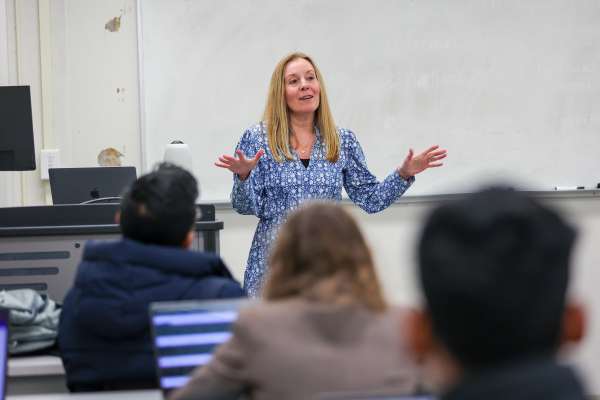Creating Vaccines: How Will They Change the Pandemic?
It has been nearly one year since SARS-COV-2 (COVID-19) changed the world. With millions of people infected and over a quarter-million dead in the United States (U.S.), the novel coronavirus continues its pervasive hold on our health and well-being.
After months of stress, frustration and uncertainty, people are itching to travel and visit loved ones during the height of the holiday season, despite increasing cases of COVID-19. As the virus continues to dominate news coverage, people are clinging to the anticipation of promising vaccine trials from Pfizer and Moderna. How will these vaccines, and potentially others still to come, change the course of the pandemic? Will we be able to return to normal and how long could that take?
“Never before in history has science been the lead story for this long,” said Vincent Venditto, Ph.D., assistant professor in the University of Kentucky College of Pharmacy’s Department of Pharmaceutical Science. “COVID-19 is giving the world a front-row seat to the scientific method and the many challenges that come with creating tools to keep us safe and healthy.”
Venditto’s expertise in vaccine design comes from his training in organic synthesis and vaccine development. Before becoming a professor in the UK College of Pharmacy, Venditto worked on vaccine development as a National Institutes of Health (NIH) postdoctoral fellow at the University of California, San Francisco.
Vaccines: How they work
It is important to know what a vaccine is and how it affects your body. The fundamental purpose of our immune system is to get rid of things that do not belong in our body. It does this by creating inflammation, which causes cells to respond and fight. Think about how your body responds when you become infected with any illness - your temperature elevates, your joints feel sore and tender, you feel fatigued – those are the effects of inflammation. Your immune system is doing what it needs to do to remove the infection from your body.
Vaccines are designed to help our immune system achieve this goal by acting as a pro-inflammatory agent. They help to stimulate your immune response without sending you to the hospital. “The goal of producing a vaccine is to build up our immune response to lessen the severity of symptoms - which keeps people out of the hospital - and to slow the transmission of disease,” Venditto said.
When you get vaccinated, your immune system generates a memory response related to the virus from the vaccine. Later, if you are reinfected with that same virus, you will have immune cells that remember exactly what they need to do to clear the infection.
One important consideration to keep in mind is that while a vaccine is intended to boost immune response, you cannot automatically consider yourself “safe” just because you are vaccinated. Vaccines do not always prevent you from getting infected. Often, they lessen the severity of the infection by helping your immune system respond. You can still get infected and you may still transmit disease. “A COVID-19 vaccine – no matter its effectiveness – will not simply get rid of the disease,” said Brooke Hudspeth, Pharm.D., an associate professor in the UK College of Pharmacy’s Department of Pharmacy Practice and Science. “It will start to cut down on the number of people needing to seek treatment in a hospital, thus minimizing its grip on the health care system, but personal protective measures, like masks and social distancing, will still be necessary to slow the spread.”
Hudspeth is a medication expert with a background in leading pharmacy immunization efforts. She practiced in community pharmacy and worked with Kroger Health before joining UK faculty.
To reach final approval, scientists must prove how effective the vaccine is at producing immune response and how well it does to slow or stop transmission.
Venditto and Hudspeth talk with Behind the Blue to explain the history of vaccines and why they are such an important tool in public health.
Vaccine development: The road to approval
It is not uncommon for a vaccine to take years to meet U.S. Food and Drug Administration (FDA) approval. There are many stages of development, from basic research to clinical trials to FDA review and subsequent post-approval monitoring and research.
“Safety is baked into the process every step of the way,” Venditto said. “If a clinical trial is halted, it does not mean that the vaccine is not safe. In fact, it is just the opposite – it means the researchers in charge are taking the steps to investigate before moving forward.”
Clinical trials happen in three phases. The first phase (Phase I) tests for safety, the second (Phase II) tests for effectiveness and the third phase (Phase III) tests for both safety and effectiveness. By the time a vaccine is in Phase III, there are 10s of thousands of participants in order to test the drug in a large population. If during Phase III, they find that people are generally not getting sicker, the vaccine is working as they anticipated, and researchers will move forward to seek FDA approval.
A common question that arises as the world waits for the first COVID-19 vaccine; how can we know that a COVID-19 vaccine is safe when the process has been so rushed?
Venditto and Hudspeth said federal financial backing plays a key role in expediting the process. They continue the conversation with Behind the Blue on Tuesday, Dec. 8, giving more insight into the past several months of development. They also discuss COVID-19 trials already underway and tell us more about who is participating.
Phase IV – Monitoring
Just because the FDA approves a vaccine initially does not mean that they cannot pull it after it is released.
“The monitoring process, Phase IV, is essential to ensure that the vaccine continues to work the way it is designed, to help keep people safe and create an effective immune response to infection,” Hudspeth said. “Data collection will continue for years after a vaccine is released.”
The FDA notes that like any drug, vaccines have benefits and risks, “even when highly effective, no vaccine is 100 percent effective in preventing disease or 100 percent safe in all individuals.” There are various ways that vaccines are closely monitored, including surveillance systems like Vaccine Adverse Event Reporting System (VAERS) and the Centers for Disease Control and Prevention’s (CDC) Vaccine Safety Datalink.
*****
When a COVID-19 vaccine is eventually released, it will not be available to everyone immediately. There will be an order in which the vaccine will be administered, starting with those populations who are at highest risk, like health care workers and essential workers, and for some in the elderly population.
As discussion of the exact rollout process continues, and even after vaccinations begin, Venditto and Hudspeth stress the importance of continuing to follow the latest guidelines, including wearing a mask, social distancing and hand washing.
“We must continue to protect our health, the health of our families and neighbors by doing the right thing and following the latest guidelines in place,” Hudspeth said.


